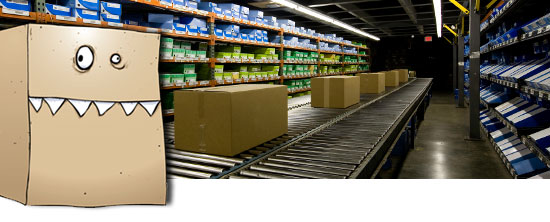Warehousing: Hidden Productivity Gremlins
What are the problems that gnaw away at your time and productivity?

Whether you’re operating a dedicated distribution center or the order fulfillment or stock warehouse of a manufacturing operation, most industrial facilities deal with storage and warehousing to some degree. In the not-so-distant past, warehousing was treated mostly as a cost center – a necessary evil that had to exist so that the more profitable parts of an enterprise could operate. Thankfully, more enlightened thought has prevailed recently.
Order fulfillment and storage are not just places you can save money – they can earn money. If the gremlins don’t get you.
Since the warehouse is often the last link in the chain that ties you to your customers, it’s important that you think of it that way. Products are picked, packaged and shipped there, and those products can be shipped to your customers, or to your internal units for further processing. Either way, doing it right is profitable, and doing it wrong is tantamount to doubling down on waste. But the problems can crop up over time, eating away at the gains you work hard to create. They’re productivity gremlins, out to chew the engine off the wing of your jet!
The most common warehouse gremlins:
Accurate inventory—or a lack thereof
Whether you’re automated or not, you must know what stock you have available. Lack of transparency into this can be devastating to profitability. You can be out of a needed item, or waste money over-ordering items you don’t need.
 Managing and maintaining inventory costs as much as 25% per year. Once you parse it, inventory, aside from its monetary costs, incurs expenses such as opportunity costs, insurance and tax liabilities, material handling expenses, warehouse overhead, inventory counting costs, shrinkage, costs…well, you get the idea. Carrying too much stock is costly. Carrying too little damages your customer relationships, flexibility, and capacity to fill orders. It’s a fine line—can you walk it consistently?
Managing and maintaining inventory costs as much as 25% per year. Once you parse it, inventory, aside from its monetary costs, incurs expenses such as opportunity costs, insurance and tax liabilities, material handling expenses, warehouse overhead, inventory counting costs, shrinkage, costs…well, you get the idea. Carrying too much stock is costly. Carrying too little damages your customer relationships, flexibility, and capacity to fill orders. It’s a fine line—can you walk it consistently?
While a warehouse of dusty, unused inventory is a terrible thing, a warehouse that doesn’t have what a customer needs when it’s needed is worse. Getting ahead of this issue requires constant vigilance, a commitment to true understanding of your inventory situation, and perhaps a willingness to automate. Automation (like many technologies) is becoming less expensive and better every year. The costs of software and hardware are stable or in decline relative to the skyrocketing costs of labor and other materials, so it’s a good idea to look at automating if you’re still manual, or to update the automated systems you have in place if you aren’t.
Poorly planned warehouse layouts and space utilization
We see warehouses all the time that were perfectly functional 18 months ago, and are a mess today. That’s the reality of a hyper-speed economy and changing customer demands. Inefficient layouts, outdated space planning, inefficient slotting, and inadequate equipment are the silent killers of warehousing efficiency. They start out as a minor pain, and by the time management realizes there is a problem, the entire operation can be wracked with gremlins like needlessly high labor costs, overtime, product damage, overstock or understock of inventory, and safety issues. The takeaway: stop working and analyze. Is your fastest moving stock still in the most convenient location? Or is it there by inertia? Are things stored in certain bin slots or rack bays because that’s the way you’ve always done it?
Having a qualified expert in to check your slotting strategies at regular intervals can help you be sure you aren’t wasting time, but in many cases you can find pressing issues on your own by stepping back and observing what’s happening in the plant.
Are you using the right storage equipment? If you are case picking from pallets, would you save money by transferring that stock to flow racks? If you changed your conveyor layout, would you slash labor costs enough to justify the expense? If you are palletizing at the end of a line, would a robotic palletizing system clear a bottleneck?
Are your processes and transactions redundant?
Many operations thrive on transactions atop transactions, piling up over the years as things change and new SKU’s, storage areas, and processes are added. These things don’t typically work well together, although you would be surprised at how well front line employees can force them to. But that situation isn’t optimal; it bleeds time, energy, and effort that you may not be aware of.
When an order picker must pass tickets (and communicate verbally to be sure it’s right) to multiple parties – packers, checkers, etc. – your process adds touches to the order. Every touch costs money and provides a chance for an error. While some redundancy is a good thing (to check for quality or to confirm pick quantity for example), too much redundancy is a productivity leech. Bar coding, pick light systems, or other technology can help alleviate some of these issues.
Keep productivity gremlins at bay by keeping your eyes open for the slow creep of inefficiency. With sensible management techniques that require evaluating best practices in inventory storage, pick processes, storage systems, and the removal of unnecessary touches, you can ward off the gremlins and ensure your operations are functioning at optimum levels.
Tags: Automation, labor, operations
Scott Stone is Cisco-Eagle's Vice President of Marketing with 35 years of experience in material handling, warehousing and industrial operations. His work is published in multiple industry journals an websites on a variety of warehousing topics. He writes about automation, warehousing, safety, manufacturing and other areas of concern for industrial operations and those who operate them.




